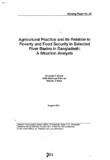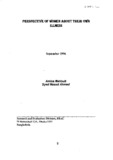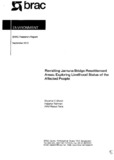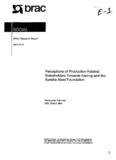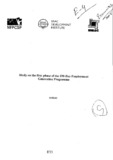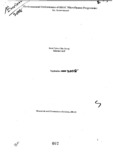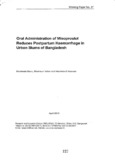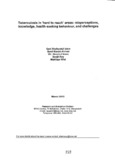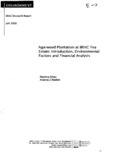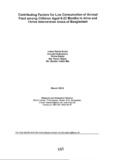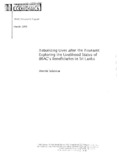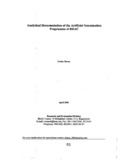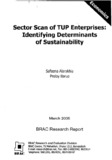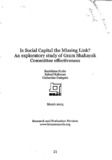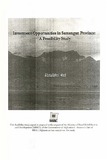BRAC Research and Evaluation Division (RED) Archive: Recent submissions
Now showing items 261-280 of 601
-
Raising sanitary latrine use in rural Bangladesh: can BRAC play any role?
(BRAC Research and Evaluation Division (RED), 1996-05)This study estimates the sanitation coverage and investigates impact of the participation in development program on the sanitation behavior in rural Bangladesh. Findings reveal that nearly a quarter of the study population ... -
Agricultural practice and its relation to poverty and food security in selected river basins in Bangladesh: a situation analysis
(BRAC, 2011-08)Poverty and food security in the context of Bangladesh has become a major concern over time. While efforts have been intensified to increase crop yield through increased land use, using inorganic fertilizers, pesticides, ... -
Perspective of women about their own illness
(BRAC Research and Evaluation Division (RED), 1996-09)Introduction In Bangladesh women's health issues are traditionally neglected and inadequate importance is given by all concerns. A majority of the women experience significant morbidity associated with pregnancy and ... -
Relapse of tuberculosis in rural areas of Bangladesh
(BRAC Research and Evaluation Division (RED), 1996-04)The study conducted to investigate the relapse rate of TB in two thanas (KahaIoo and Furbari) of ' Women's Health and Development Programme (WlIDP) in August 1995. Of the 482 study cases, 435 (900A» treatment completed ... -
Revisiting Jamuna bridge resettlement areas: exploring livelihood status of the affected people
(BRAC, 2010-09)Jamuna Multipurpose Bridge (JMB) project was the first of its kind which incorporated resettlement activities facilitating livelihood restoration of the project affected people (PAP). This study was an endeavor to reveal ... -
Perceptions of production related stakeholders towards Aarong and the Ayesha Abed foundation
(BRAC, 2010-04)Aarong and Ayesha Abed Foundation were established to support the artisans and rural women in Bangladesh. Thus, these production-related stakeholders are very · important for Aarong and AAF. This study was initiated to ... -
Study on the first phase of the 100-day employment generation programme
(BRAC, 2009-02-10)In September 2008, the Government of Bangladesh embarked on the first phase of a 100-day Employment Generation Programme (EGP) for the poorest and jobless poor. This endeavour came in response to the soaring food price. ... -
Environmental performance of BRAC microfinance programme: an assessment
(BRAC, 2008-09) -
Ecosystem services and poverty linkages in Bangladesh
(BRAC, 2008-01)What is the relationship between ecosystem services and poverty alleviation? Finding answers to this question is vital if resources are to be used sustainably and to alleviate poverty. However, this is a question that ... -
Oral administration of misoprostol reduces postpartum Haemorrhage in urban slums of Bangladesh
(BRAC Research and Evaluation Division (RED), 2013-04)To avert deaths from postpartum haemorrhage (PPH), Manoshi initiated community health workers (CHW) administered oral misoprostol (400~g) to women following childbirth either at delivery centers or home in slums of Dhaka ... -
Tuberculosis in 'hard to reach' areas: misperceptions, knowledge, health-seeking behaviour, and challenges
(BRAC Research and Evaluation Division (RED), 2013-03)This study was conducted to explore the knowledge and perceptions of health workers and community people about tuberculosis in geographically inaccessible (hard-to-reach) tuberculosis (TB) programme areas of BRAG. The ... -
Agarwood plantation at BRAC tea estate: introduction, environmental factors and financial analysis
(BRAC, 2008-06)The Aquillaria malaccensis (known as agar) produces agarwood which is used in perfumes, incense and medicines, and thus, can be extremely valuable. Excessive harvesting of agarwood has made this species threatened. ... -
Knowledge and practice of formal physicians regarding control and prevention of TB in light of national guidelines
(BRAC Research and Evaluation Division (RED), 2013)The study explored the current knowledge and practice of interns and general physicians regarding control and prevention of tuberculosis in light of national guidelines. The study was conducted on 13 public and seven ... -
Mother knowledge and health-seeking behavior towards childhood TB
(BRAC Research and Evaluation Division (RED), 2013-03)Introduction: BRAC in association with NTP recently started the community-based child TB programme. So far, no independent study has been conducted to explore the extent to which the objectives of the programme have been ... -
Contributing factors for low consumption of animal food among children aged 6-23 months in alive and thrive intervention areas of Bangladesh
(BRAC Research and Evaluation Division (RED), 2013-03)Introduction: In Bangladesh about two-thirds of total food consumption is rice as main staple food, especially for the poor, in addition to some vegetables, pulses and small quantities of fish, meat, egg, etc. if and ... -
Rebuilding lives after the Tsunami: exploring the livelihood status of BRAC's beneficiaries in Sri Lanka
(BRAC, 2006-03)BRAC Sri Lanka started rehabilitation and livelihood support programme for the tsunami-affected people about 6 months after the disaster. Though the programme components include a range of rehabilitation and livelihood ... -
Analytical documentation of the artificial insemination programme of BRAC
(BRAC, 2006-04)This paper intends to have feedback of the stakeholders of BRAC artificial insemination (AI) programme that could be useful for the programme. The findings show that implementers have to compete with other service provides ... -
Sector scan of TUP enterprises: identifying determinants of sustainability
(BRAC, 2005-03)A key objective of the CFPR-TUP programme to assist the ultra poor is the development of sustainable livelihoods, through the transfer of assets and skills to specially targeted ultra poor members for income generation. ... -
Investment opportunities in Samangan province: a feasibility study
(BRAC, 2005-12)


